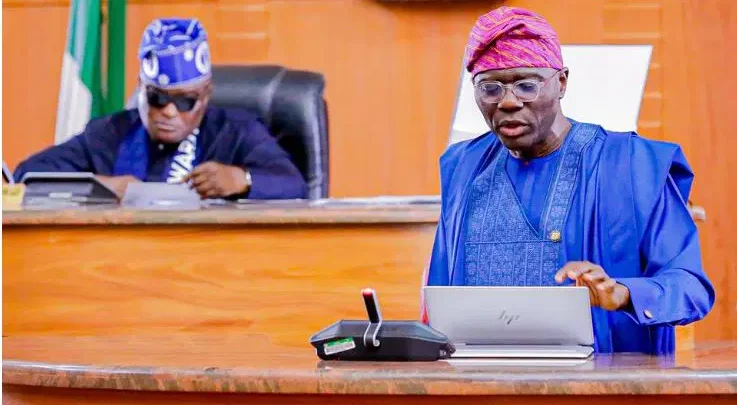• How Stakeholders Saved National Theatre From Being Sold
• Facility Now A Joint Venture Company, National Theatre Partners Limited
• Endowment Fund For Maintenance, Others Underway — President Tinubu
• I’m Excited But Cautious That President’s Directive Is Not Motivated By
A Concern For Establishment Of NEA — Ojewuyi
From the gate to the complex, the well-mown lawn appeared welcoming, while the trees swayed to rhythms of the wind. The massive movement of visitors was noticeable, as security agencies took over every nook and cranny of the complex. Everywhere was warm: A spectacle to behold.
Even Abeigi, the popular hangout in the complex, was condoned initially to prevent miscreants from gaining access into the facility. Every visitor struggled to get accreditation and enter the place before gate was closed at 4:00pm. Hosts of the bespoke event, Dr Henry Nzekwu and Eugenia Abu, handled activities in a fashion that was compelling.
It was a roll call of high networth guests, politicians and the arts community, and leading the commune were President Bola Ahmed Tinubu, First Lady Senator Oluremi Tinubu, Senate President Godswill Akpabio, Speaker of the House of Representatives Tajudeen Abbas, Prof Wole Soyinka, National Assembly members, Governor Babajide Sanwo-Olu, Minister of Arts, Culture, Tourism and Creative Economy, Hannatu Musawa and other dignitaries that graced the occasion.
If the environment wore the best of what could be imagined as a first class facility, the spectacle at the venue of the reopening and rededication ceremony of the now christened Wole Soyinka Centre for Culture and Creative Arts quite reawakens the consciousness of stakeholders in the arts and aficionado who thronged the place in their number — The reopening represented another significant milestone in the nation’s cultural and economic revitalisation strategy as culture experts noted.
Welcoming guests, Governo Babajide Sanwo-Olu of Lagos State described the project as the heartbeat of the nation’s course for development and a rebirth of a national icon and a celebration of Nigeria’s creative soul.
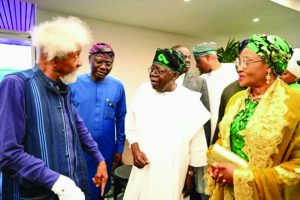
“It was here that we showed what was possible when culture led the way, when art became the language of unity. That same spirit lives here today,” he said.
While thanking the president for gracing the reopening on the special occasion of the nation’s independence anniversary, he said the state was proud to be a key stakeholder and a partner in the project and had developed infrastructure, including the Blue Line Metro train with a dedicated facility at the theatre.
He added that hosting the president during Nigeria’s 65th Independence anniversary was deeply symbolic, as Lagos was the same city where the Union flag was lowered and the Green-White-Green flag hoisted for the first time in 1960.
Sanwo-Olu noted that despite its proud beginnings, the edifice had been neglected for decades until the Federal Government, the Central Bank of Nigeria, the Bankers’ Committee and Lagos State joined forces to restore it.
“Lagos State is proud to have been a key stakeholder and partner in this project, and we have demonstrated this in every concrete way. First, we ensured that the Blue Line meshed through, which had dedicated stops here at the complex. Then, the restoration began. We contributed a sizable portion of additional land to enable the development of world-class creative art around this theatre. What this means is that today’s commissioning is only the beginning.”
Paying glowing tribute to Nobel laureate Professor Wole Soyinka, in whose honour the theatre has now been renamed, Sanwo-Olu said: “I cannot conclude without paying special tribute to the man, the icon, after whom this centre has now been renamed by His Excellency, Mr. President —Professor Oluwole Akinwande Soyinka, Africa’s first Nobel laureate in literature.
“His works are proof of our beloved city’s enduring inspiration. With this official opening, we are confident that Prof. will be spending even more time here in Lagos, staging his landmark works and creating new ones for us.”
While accepting the renaming of National Theatre after him, the venerable writer and Nobel laureate said he accepted it with mixed emotions, despite being a critic of many past leaders, who appropriated public monuments.
“I have been guilty of saying other people do not merit this kind of monumental dedication, and then I had to stand up in public and watch my name being put up as yet another appropriator. It just didn’t seem well with me. I’ll be modest, given the general estimate, to say that about 25 percent of monuments, whether they are buildings or roads in particular in this country, are well and truly deserved,” the writer said.
Reflecting on the history of Nigerian theatre and pioneers such as Hubert Ogunde and opera composer Adam Fiberesima, Soyinka said he ultimately concluded that “somebody has to carry the can.”
He explained that before the renovation of the edifice, he thought it was irredeemable, but the Bankers’ Committee “made me eat my words.” He said the Bankers’ Committee had done a great job and brought the edifice to global standards. He said that with the recreation of the edifice, Nigerians can now watch Africa Theatre at home instead of travelling abroad.
Commending the transformation of the building, Soyinka noted, “If eating one’s word produces a morsel like this, then it’s a very tasty set of words.”
The Governor of Central Bank, Olayemi Cardoso, said the CBN, the Bankers’ Committee, the Lagos State government, and the Ministry of Arts, Culture and Creative Economy came together with a shared purpose to deliver the project.
Cardoso believes Nigeria’s creative industries are engines of growth, with the potential to generate billions in yearly revenue while creating millions of jobs.
“Yet, beyond economics, culture is about identity, pride, and the very soul of a nation. With this restoration, we’re investing in our youth, in our stories, and in Nigeria’s rightful place on the global stage,” he said.
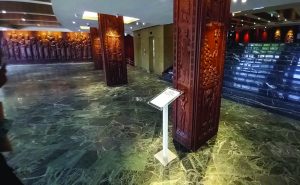
An Eagle In The Sky
THE contract of this elegant structure that was built with an excellent outlook for the creative industries was signed on April 24, 1973. The main building contractor was a Bulgarian company called TechnoExportStroy. The chief architect was Stefan Kolchev, the same person who designed the Palace of Sports and Culture in Varna, Bulgaria.
A team led by the then Minister of Information, Anthony Enahoro, was said to have visited Europe and the United States to look around and get ideas on what a National Theatre should look like. In 1972, the delegation was said to have visited Bulgaria, and was highly impressed by the Palace of Sports and Culture (completed in 1968) in Varna, a coastal city like Lagos, and decided to build a similar structure in Nigeria.
Its design was based on a Bulgarian sports centre. It consists a main auditorium, which could seat 5,000, a large Conference/Banquet Hall; 2 Cinema/film Halls, Exhibitions Halls, and a variety of other rooms. The National Theatre also accommodated Radio and Television studios and recording facilities. The Theatre car parks had space for 5,000 cars. There was a Police Station to ensure a high level of security and a clinic, which had a former minister and senator of the Federal Republic as the resident doctor.
The whole building was embellished throughout with Nigerian art works that included those of some Nigeria’s foremost visual artists including Erhabor Emopkae, Yusuf Grillo, Lamidi Fakeye and Bruce Onabrakpeya. These transformed an architectural masterpiece into a museum and art gallery.
Visible from the Second Mainland Bridge, popularly called Eko Bridge, which connects Lagos Island and the mainland, the iconic modern structure rises up to seven storeys, more than 31 meters into the sky.
“Nigerians called the design ‘Fila Gowon’, because its shape was like a General’s cap.”
After General Yakubu Gowon was overthrown on July 29, 1975, it was later known as ‘Fila Murtala’ (after General Murtala Muhammed, who took over from Gowon).
The complex served as a venue for the Second World Black and African Festival of Arts and Culture (FESTAC ’77), which Nigeria successfully hosted in January/February 1977.
For so many years, the facility received diverse entertainers, artists and actors who flocked the edifice regularly to showcase their works and talents. It became a go-to theatre hub for stakeholders in the creative industry, especially American music artistes such as Shalamar, Skyport, among others. However, the trajectory changed because of lack of maintenance and other factors that are often ascribed as ‘Nigerian’.
At its zenith, the National Theatre pulsed with life. It hosted FESTAC ’77 – a landmark festival celebrating Black and African arts and culture – with over 17,000 participants from across Africa and the diaspora. The theatre became a beacon for playwrights like Wole Soyinka and dramatists staging productions such as Camwood on the Leaves and Isiburu. It was not just a building; it was a declaration of Nigeria’s creative prowess to the world.
The Eyesore Of A Nation
DESPITE its promising start, the theatre’s fortunes waned over time. By the late 1980s, economic downturns, shifting political priorities, and bureaucratic inertia led to chronic neglect. Routine maintenance was abandoned; leaking roofs, malfunctioning air conditioning systems, and structural decay became emblematic of broader mismanagement.
The military regimes that dominated much of Nigeria’s post-independence history had little interest in artistic expression beyond ceremonial performances for VIPs. Funding for the arts dwindled, forcing the theatre’s management to rent out spaces for weddings and church services just to stay afloat. As live theatre lost relevance to Nollywood and digital platforms, opportunities for performers diminished. Many sought creative prospects abroad, fuelling a brain drain that weakened Nigeria’s artistic ecosystem.
The ripple effects extended beyond artists. Cultural tourism stagnated as Nigeria failed to capitalise on its creative industries. Where Broadway in New York and London’s West End generate billions annually through cultural tourism, Nigeria’s National Theatre became a symbol of wasted potential – a husk of what could have been an economic powerhouse.
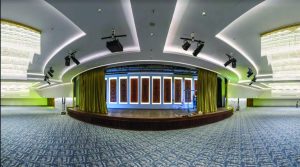
By 1991, there had been no routine maintenance of the building by the Bulgarians responsible or anyone else and it gradually ceased to function. The roof of the main auditorium was the first to crack: water fell into the hall, and began to destroy the stage, the seats, the lighting and amplification system, and priceless art works.
Soon the crack on the auditorium roof spread to the other wings. The floor of the Theatre became saturated, and a safety hazard. To prevent anyone being electrocuted, the mains supply lines were severed. Soon the central air-conditioning failed. This meant that the building – designed to operate in a temperate climate – became unbearable hot.
It was described as an ‘oven’, and there were no possibilities for adaptation: openings could not be made to allow for cross ventilation. The ‘architectural masterpiece’, the ‘major legacy of Festac 77’, was gradually becoming a structural nightmare, a millstone around the necks of theatre lovers.”
To save the National Theatre, the Ministry of Culture, Youth and Social Welfare established the National Theatre and the National Troupe of Nigeria as separate parastatals. They were allocated separate budgets and charged to run the National Theatre as a semi-professional state outfit. A management team of five was appointed, led by Jimmy Atte, a senior television producer, who became the first independent General Manager.
Before the restoration, the complex was an eyesore, as the surroundings, including the canal, were filled with refuse of different materials. Everywhere smelt. Apart from dirty surrounding, the perimeter fence was in a dilapidated condition, while the edifice was an environmental nuisance.
The situation on ground had also become worrisome for people within the premises. Shop owners saw the place as a security risk and a clear danger to lives and property in the neighbourhood.
Residents of Costain, Apapa Road, Ijora and the environs had even called on government to clear illegal structures around the facility, which they alleged, had become a haven for criminals.
In 1999, when he came back as civilian leader, Obasanjo, who opened the facility, found the situation, had deteriorated very seriously. In anger, former President Olusegun Obasanjo adopted a ‘privatisation’ policy and put the National Theatre at the top of then ‘for sale’ list – followed by Tafawa Balewa Square, and the International Trade Fair Complex. To manage the sell-off, Obasanjo set up the Bureau of Public Enterprises (BPE). However, Obasanjo’s plan to privatise the facility in 2001 sparked controversy among the Nigerian arts community, which was shelved.
The idea of sale prompted furious protests from artists’ community to save the place in 2001. This long, enduring protest, which lasted for two decades, was galvanised after the September Arts Stampede of Committee for Relevant Arts (CORA) in 2001, which held at the National Theatre field with Coalition of Nigerian Artists (CONA) in the forefront.
The idea to privatise the place gained currency again in 2007, which led to a series of meetings, demonstrations, rallies and protests against the proposed sale/concessioning of the facility.
Led by the Coalition of Nigeria Artist (CONA), arguments were advanced on how such facilities in other climes have functioned. According to CONA, “all over the world, human communities, including nations, states, cities and other communities set up official cultural centres to: signalise the community’s cultural arrival; embody its artistic values; showcase its artifacts; and incubate the progressive development of its creative expressions.
“Because of the importance of the foregoing roles of a national cultural centre, national cultural centres are never: Left in the hands of public bureaucracies without specialized training and hands-on experience in facility management and the business of art and entertainment venues; nor concessioned to private entities to govern and operate; operated with a view to making profit.”
CONA acknowledged the need for the resuscitation of the facility for the fulfilment of its mandate as the Nigerian national cultural centre and the centre of arts and performances in the black world, as was conceived during the Festival of African Art and Culture (FESTAC) and proposed a study group of stakeholders and experts be commissioned to analyse the nature and structure of successful Public Private Participation in the operation and funding of National Cultural Centres world-wide and the appropriate legal and other frameworks for such a PPP established before inviting private participation under the framework.
The Bureau for Public Enterprises (BPE) had established the framework for concession and hosted an open bid for it, after a widely publicised call for expression of interest. It eventually announced Infrastructica as the preferred bidder with a bid of N35.8 billion for a 35-year concession of the National Theatre. It also declared Jadeas Trust, which offered N28.9 billion, as the reserved bidder.
Infrastructica was expected to rehabilitate, run and also upgrade existing facilities, including the cinemas, halls, and develop 12,000sqm of available re-developable space. The company was also expected to develop games arcade, amusement park, theme parks and arts galleries.
A committee was set up in September 2012, during the tenure of High Chief Edem Duke as minister of Tourism, Culture and National Orientation to look into the possibility of Public Private Partnership (PPP) in the management of the facility.
The committee had representatives of the Federal Ministry of Housing, Infrastructural Regulations Committee and Surveyor General as members. The committee engaged VGL Consultants, a foreign consulting firm, to look into ways of turning around the surroundings of the theatre.
The committee report favoured an establishment of a five-star hotel, which the critical and very alert culture community resisted before it was finally shelved. However, determined to preserve key national monuments in the country, the Senate called on the Federal Government to, as a matter of urgency, stop the planned sale of Tafawa Balewa Square, and the National Theatre, Iganmu, both in Lagos.
The upper legislative chamber declared that both establishments as well as the President’s House at Marina, the Prime Minister’s Lodge, Onikan, and the National Assembly Complex, Lagos, were national monuments that should be preserved. It, therefore, directed the Federal Ministry of Information and Culture to immediately develop monuments into viable tourists’ attraction for the country.
These resolutions followed a motion, “Proposed sale of the National Theatre and the Tafawa Balewa Square, Lagos by the Federal Government of Nigeria” sponsored by Senator Fatimat Raji-Rasaki.
Leading the debate on the motion, Raji-Rasaki said the media was recently awash on the sale of assets belonging to the federal government, including the National Theatre and the TBS in Lagos to raise more funds to finance the 2018 budget.
According to her, the TBS “represents the landmark on which Nigeria got the instrument of nationhood at a ceremony on the morning of October 1, 1960 when the Union Jack was lowered down and the green-white-green national flag was raised and hosted.”
She informed that the National Theatre was specifically built to host the 2nd Black African Art Festival named the Festival of Art and Culture (FESTAC) in January/February 1977, where all black people across the globe gathered to celebrate the uniqueness of the black race.
Senator Raji-Rasaki said that these institutions and structures occupied historical landmarks, monument and serve as symbols of the country’s nationhood, desires and attainments, adding, “these economic and culture values are immeasurable to our cultural pride and symbols of nationhood that can be readily developed as tourists’ attraction and also for the teaching of history and civic studies.”
She advised that, “instead of disposing these edifices to private use, the federal government can look for other alternative sources of developing the Tafawa Balewa Square into an attractive profit-making tourists centre.”
Restoration Of An Edifice
ON October 5, 2019, the late President, Muhammadu Buhari, approved the reconstruction of the National Theatre in Iganmu, Lagos, into a world-class convention centre for the development of the creative sector in diverse areas, including entertainment, movies, music, fashion, and Information and Communication Technology (ICT).
According to the Bankers’ Committee, a portion of the site was earmarked for the construction of the “Signature Cluster”, which consists of one building each for Fashion, Music, Film and IT.
The committee said each structure was uniquely designed to function independently, yet providing the opportunity for extensive collaborations between the different creative communities.
As the initial investment in the creative industry, the government expects to create at least 1 million jobs when the project begins operations.
After 20 years of battle with stakeholders in the creative economy, the Federal Government handed over the theatre complex, alongside the 44 acres of barely developed land, to the Bankers’ Committee in July 2020 for renovation and recreation of the complex into a job and wealth creation venture for the creative industry and related industries.
The then Governor of Central Bank of Nigeria, Godwin Emefiele, assured the public of the sincerity of purpose of the Bankers’ Committee and the CBN on delivering, and that work would commence in early 2021, completed and commissioned in November 2022 by President Muhammadu Buhari.
The renovation of the national landmark commenced in July 2021, following approval by the Federal Government and the subsequent handover of the national edifice to the Bankers’ Committee, and was completed in August 2024. It was, however, not complete till 2023 when Buhari left office.
However, prior to the completion in August 2024, the national edifice was renamed Wole Soyinka Centre for Culture and the Creative Arts by President Bola Ahmed Tinubu. The President renamed the facility in a birthday message to the Nobel laureate who turned 90 on July 13, 2024.
On Wednesday, August 28, 2024, the Bankers’ Committee announced the completion of the restoration and upgrading of facilities at the National Theatre. The renovation works covered different spaces, including the 5,000-seater main bowl, which is now 4600, over 3,000-seater banquet hall, two exhibition halls, three cinema halls, VIP spaces, actors’ changing rooms, industrial kitchen, over 300 new toilet cubicles, clinic, fire station, lobbies within the four National Theatre entrances and extensive roof repairs.
The facilities were upgraded to match with the best standards of theatre and performance in the world. The upgrading includes the replacement of the entire Heating, Ventilation and Air Conditioning (HVAC) system, upgrade of the fire safety standards, power, replacement of the water supply and sewage systems, upgrading of interior design with the installations of Audio Video Lighting (AVL), world stage engineering system, 17 passenger lifts, solar power, new furniture for spaces and restoration of artworks including those on the internal wall panels and the building façade.
External works supporting the National Theatre were also carried out in the refurbishment of the three entrance gatehouses, constructions of four themed landscapes, car park block (250 cars), the ring road, and installation of external street lightings and CCTV cameras.
Speaking during a tour of the monument, Managing Director/Chief Executive Officer of Sterling Bank Group representing Bankers’ Committee, Mr. Abubakar Suleiman, disclosed, “when we approached government for this opportunity, we had no idea how we were going to make money. It wasn’t about making money. This was about a national monument that had been left abandoned, and we thought anything and everything that needed to be done should be done to restore this to its glory.
“We were shocked at the scale of the work that needed to be done, but we were also impressed by the possibility that it represented. As you’ve seen, this is one of the largest-scale projects of this type anywhere on the continent. The standard to which it has been restored is global,” he added. “The standard to which this edifice has been restored is world class.”
For him, the renovation of National Theatre by the Bankers’ Committee showcases what is possible with the power of patriotism and collective responsibility on the part of the private sector in partnering with the Federal and Lagos State governments, “to reignite hope and revive some of our national monuments and assets.”
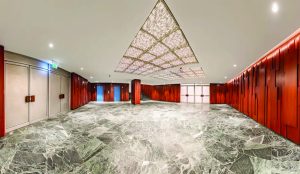
Endowment Fund For Maintenance, Others
THE gap, which many felt could be a threat to the facility, was maintenance. However, President Tinubu, waiting for the last minute to serve the best, called on the Central Bank of Nigeria (CBN) to establish an endowment fund.
The President said he would personally contribute to the proposed fund, which is aimed at supporting long-term growth and sustainability in Nigeria’s creative industry.
Already, the theatre is now into a Public-Private Partnership with the Federal Government, through the Ministry of Arts, Culture, Tourism and Creative Economy and the Bankers Committee through the SANEF Creatives Limited. The parties have agreed to form a joint venture company, Theatre Partners Limited, which will manage the complex.
Members of the Board of Directors include, Disun Holloway, Chairman; Mrs Adetola Akerele, Haruna Musa, Mrs Ayona Aguele-Trimnell, Audu Maikori, Dr Nneka Onyeali-Ikpe and Dr Osahon Okunbo.
Too Many Funds But Limited Access
THE Federal Ministry of Arts, Culture, Tourism, and Creative Economy (FMACTCE), early this year, announced the rollout of the Creative Economy Development Fund (CEDF or the “Fund”), designed to catalyse growth, innovation, and sustainable financing for Nigeria’s creative and cultural industries, in line with the government’s commitment to creating jobs, stimulating economic diversification, and boosting Nigeria’s global cultural footprint.
This Fund represents a significant national investment in the creative sector, recognizing its potential as a driver of economic growth and cultural diplomacy.
Before now, the CBN and the Bankers’ Committee established the Creative Industry Financing Initiative (CIFI) in 2018 as part of efforts to boost job creation in Nigeria, particularly among the youth.
The initiative has four Verticals: Fashion, Information Technology, Movie, Music, and depending on the vertical, applicants can access loans ranging from ₦3 million to ₦50 million, and ₦500 million for movie distribution business. Training, equipment and rental/service fees also be covered under the facility for fashion and other ICT entrepreneurs.
Objectives of the facility include to improve access to long-term, low-cost financing to entrepreneurs and investors in the Nigerian creative and information technology (IT) sub-sectors. Initiative targeted at: Existing enterprises in the creative industry; Start-ups engaged in the creative industry; and Students of higher institutions engaged in software development.
Segun Ojewuyi, Professor/Head of Directing at the Southern Illinois University (SIU), Carbondale, Illinois, said: “When we talk about our creative arts and culture, we are not only talking about the world of economic growth, which is very critical, but also talking about the human condition that motivates a people for development and growth. Our values and quality of life are grounded in our humanity funded by our culture, values through the arts.”
According to him, “the breaking news came at the very end of President Tinubu’s speech. It was the charge openly and directly given to the Governor of the Central Bank, Cardoso. It is now a standing directive to establish the endowment fund! This is something we have been advocating for many years, over three decades now. It confirms that the politicians have been hearing us but never considered our position expedient to them. I am very excited and given the diligence and successful completion of the renewed culture and the creative arts centre, one can be very hopeful that Cardoso will pull together the necessary financial tools to make it possible.”
Ojewuyi said: “I am excited but I am cautious that Mr. President’s directive is not motivated by a concern for the establishment of the fund to support the sustainability of the building but the renewed commitment to the development of our culture and creative arts.”
According to him, “every nook and cranny of our great nation should feel the seeds of the endorsement fund.” Also speaking with The Guardian, President of National Association of Nigerian Theatre Arts Practitioners (NANTAP), Adeniran Makinde, said, “an endowment fund is more than just a financial pool—it represents long-term stability. Managed professionally, such funds provide steady streams of income to support artistic programming, training, preservation of cultural heritage, and the maintenance of landmark institutions like the National Theatre. For artists, it reduces the uncertainty of funding cycles, ensuring that creativity thrives without being stifled by financial instability.”
He said, “in many leading cultural nations—such as the United States, United Kingdom, and France—endowment funds serve as the lifeblood of their global cultural diplomacy. Institutions like the Metropolitan Museum of Art or the British Council do not simply depend on annual allocations; they draw from endowment-backed revenues that give them financial resilience and creative autonomy.”
According to Makinde: “Beyond the arts sector, endowment funds strengthen national soft power—a nation’s ability to influence global narratives through culture, values, and ideas rather than military or economic might. Nigeria, home to Nollywood, Afrobeats, and a vast literary tradition including theatre, has already carved a cultural footprint across continents. With a robust arts endowment, these strengths can be systematically projected as instruments of global governance and diplomacy.”
Soft power often shapes international perceptions. From Hollywood shaping American identity to K-Pop and Korean drama repositioning South Korea, cultural exports backed by institutional funding drive influence. For Nigeria, an endowed arts and culture sector could amplify its role in African leadership, boost tourism, and ensure its voice resonates in global cultural policymaking.
By tying the launch of the Wole Soyinka Centre to the announcement of the Endowment Fund for the Arts, Tinubu has signaled a deliberate shift from short-term arts patronage to sustainable cultural financing. The Centre is envisioned not just as a performance space but as a hub of cultural diplomacy, intellectual exchange, and artistic innovation.
Professor Emeritus dele jegede said, “my first intuitive reaction was that the bankers should be saddled with the responsibility of managing the edifice: they should work on making sufficient money to maintain the place and then anything extra would go towards the new national endowment.”
Analysts suggest that if well-managed, the endowment fund could become a model for other African nations, positioning Nigeria as a leader in cultural governance on the continent. More importantly, it can safeguard Nigeria’s cultural institutions from the unpredictability of political cycles and economic downturns.
“As Nigeria steps into this new phase, the message is clear: cultural sustainability is not a luxury, but a strategic necessity. By investing in an arts endowment, the nation is not only preserving its heritage but also strengthening its voice in the evolving arena of global governance,” he said.
A National Endowment for the Arts Act was established in 1991, but it has faced implementation challenges. While the act exists to provide funding and support for the arts and culture sector, it has been noted that practical efforts at implementation have been limited, though the government has expressed intentions to amend the act in recent years to better support the industry.
The act objectives of the Endowment shall be- (a) to support every medium and area of creative activity in the field of art as a service to the Nigerian community; (b) to support the exchange of knowledge and practice in the arts; (c) to preserve Nigeria’s rich cultural heritage for present and future generations of Nigerians; (d) to foster understanding amongst cultural organisations in order to strengthen cultural ties amongst them; (e) to support creativity among talented artists in Nigeria in order to ascertain and pick, for the development of cultural activities, the best talents among Nigerians; and (j) to foster professional excellence in the arts and create a climate in which it might nourish and be enjoyed by the generality of Nigerians.
The immediate past Minister of Information and Culture, Alhaji Lai Mohammed, while chairing the Virtual Forum of the African Union Ministers responsible for Arts, Culture and Heritage in Abuja, had said the Federal Government would amend the Act establishing the National Endowment for the Arts to enable it to play a pivotal role in responding to the demands of the sector.
“We have decided to amend the Act establishing the National Endowment for the Arts so it can better meet the demands of the sector, which has been greatly impacted by the pandemic.
“The main objectives of the Endowment are to support every medium and area of creative activity in the art, culture and heritage sector as well as to foster professional excellence in the sector.”



